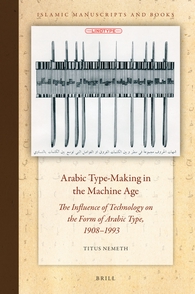
Arabic Type-Making in the Machine Age: The Influence of Technology on the Form of Arabic Type, 1908-1933, Vol. 14
Tom Verde
Titus Nemeth
2017, Brill, 9-789-00430-377-5, $156 hb.
The first Arabic typefaces did not appear until the early 16th century. Yet with the demands for “international document exchange” in an increasingly globalized economy over the last century, it “comes as no surprise that Arabic [is now] the second most widely used phonemic script in the world” and “plays a leading role” in international communications, commerce and trade, Nemeth writes. His deeply researched, wide-ranging history of mechanized Arabic script in the 20th century examines its challenging entré onto the modern, printed page. Highlights include the introduction of the Arabic typewriter (patented by Egyptian Selim S. Haddad in 1899), that prevailed over the “major obstacle” of rendering Arabic calligraphy into mechanical type, and its earliest appearances on computer screens in the early 1970s via programs called Katib (scribe or clerk) and Hattat (calligrapher), “a reflection of their respective functionality.” This detailed study features numerous illustrations of Arabic fonts and early printed pages in Arabic.
